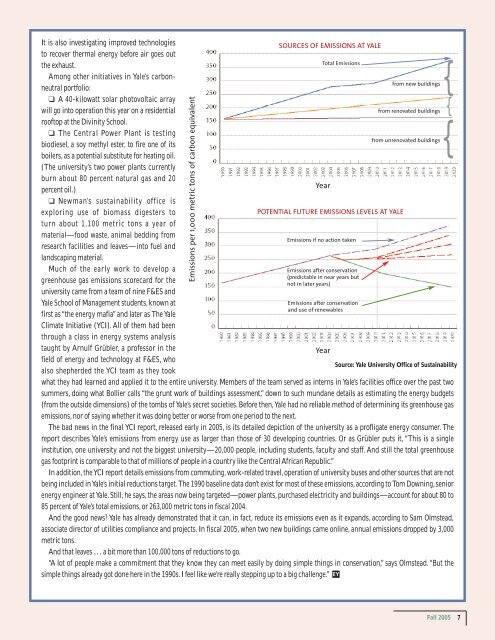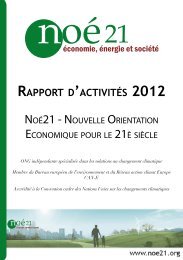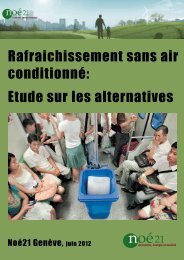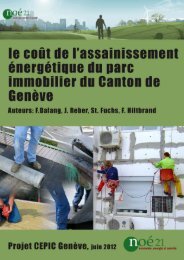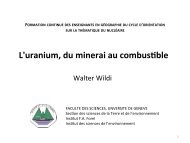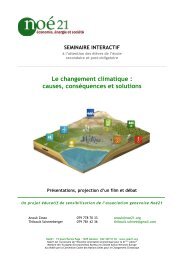Yale Adopts Bold Climate Strategy in Midst of Major ExpansionBy Richard ConniffOne way <strong>to</strong> gain perspective on the relative importance of forests in the global warming debate is <strong>to</strong> considerYale itself. The university owns and manages nearly 11,000 acres of New England forest, the bulk of it in theYale-Myers Forest in northeastern Connecticut. These forests removed the equivalent of 6,300 metric <strong>to</strong>ns ofcarbon dioxide from the atmosphere in 2002, according <strong>to</strong> a recent study by F&ES students. But the university’s<strong>to</strong>tal emissions that year added up <strong>to</strong> about 285,000 metric <strong>to</strong>ns. To offset that much pollution, Yale wouldneed a half-million-acre forest. Think of it as a stand of trees 12 miles deep stretching roughly from New Haven<strong>to</strong> New York.In other words, forests will continue <strong>to</strong> be a part of the carbonportfolio. But for real change <strong>to</strong> occur, the university will have <strong>to</strong> pay farmore attention <strong>to</strong> how it produces, procures and consumes energy.With that in mind, Yale officials led by President Richard Levinannounced in Oc<strong>to</strong>ber that over the next 15 years the university willreduce its greenhouse gas emissions by 10 percent below 1990 levels.Citing the work of Dean Gus Speth in his book Red Sky at Morning:America and the Crisis of the <strong>Global</strong> Environment, the announcementdeclared that “addressing CO2 emissions from fossil fuels must be thebedrock” of a successful climate strategy. The announcement alsocommitted Yale <strong>to</strong> becoming a “model university” by preparingstudents for the “pressing” environmentalchanges ahead.Speth welcomed the Yale commitment as “abold and very important initiative,” and anexample <strong>to</strong> other universities. But theannouncement also elicited criticism.“I apologize for raining on the parade here, butI think the university is bringing up therear when it is expected <strong>to</strong> be a leader,” saidauthor and environmentalist Paul Hawken in ane-mail <strong>to</strong> Speth. In his reply, Speth said, “Thoseinstitutions taking the lead <strong>to</strong>day <strong>to</strong> commit <strong>to</strong> emissions reductionswill almost certainly be adopting more demanding measures beforelong. … It’s the beginning, not the end, or even the middle.”In fact,Yale is one of the first universities in the country <strong>to</strong> set anygreenhouse gas emissions target. (Among other leaders, Cornell andTufts universities previously committed <strong>to</strong> reducing greenhouse gasemissions by 7 percent from their 1990 baselines, by 2008 and 2012,respectively.) Moreover,Yale’s initial reduction target is likely <strong>to</strong> provefar more challenging than it sounds. Since 1990, the university hasactually increased its greenhouse gas emissions by 55 percent.The increase is due largely <strong>to</strong> rapid growth on campus, particularlyin energy-intensive science buildings, according <strong>to</strong> JohnBollier, associate vice president for facilities operations. Greaterreliance on air conditioning and high-tech equipment has alsohelped drive up emissions at about double the university’s 1.2percent annual rate of growth in floor space. Moreover, the universityexpects <strong>to</strong> increase its rate of expansion at least through 2020. (The“I feel like we’rereally stepping up<strong>to</strong> a big challenge.”plans include a new home for F&ES, which the architects are working<strong>to</strong> make a model of low-energy consumption.) “But you can’t justsay, ‘We’re a growth institution and somebody else has <strong>to</strong> do it,’”says Bollier. The bot<strong>to</strong>m line: <strong>to</strong> get 10 percent below 1990 emissionsof 163,000 metric <strong>to</strong>ns, the university will have <strong>to</strong> cut overallemissions by about 44 percent from current levels—in the middle ofa major expansion.How will the university achieve its goals? In announcing thegreenhouse gas initiative, university officials challenged the Yalecommunity <strong>to</strong> reduce energy use by 15 percent in the residentialcolleges and 10 percent in all other buildings over the next threeyears. For every 5 percent savings in a college,Yale also promised <strong>to</strong> purchase offsets (orrenewable energy certificates) equal <strong>to</strong> onethirdof the college’s remaining electricitybudget. Some of the savings will come fromadjusting thermostats, replacing incandescentlight bulbs with compact fluorescent bulbs andinstalling sensors <strong>to</strong> switch off lights inunoccupied areas.But Yale will never achieve the 10 percenttarget “just by technical solutions,” says JulieNewman, direc<strong>to</strong>r of Yale’s new Office of Sustainability. “You have <strong>to</strong>get people involved.” She’s helping lead a campaign <strong>to</strong> educatemembers of the Yale community <strong>to</strong> buy only Energy Star-labeledhardware, turn on the power-save mode—and shut off computerswhen not in use. Newman says that changing computer use alonecould eliminate 935,000 pounds (424 metric <strong>to</strong>ns) of carbon dioxideemissions a year.The university says it will also tweak its own operating practices.At the suggestion of an hourly worker, for instance, it recentlypurchased a $20,000 thermal camera <strong>to</strong> improve moni<strong>to</strong>ring of the50,000 or so steam traps on campus. When a trap fails, more or lessat random, it sends steam literally down the drain. Better moni<strong>to</strong>ringcould save about $100,000 in fuel costs annually, according <strong>to</strong> Bollier,with an equivalent reduction in greenhouse gas emissions. In sciencebuildings, where inside air was being completely replaced by outsideair 12 <strong>to</strong> 15 times per hour, well above the recommended safetylevel, the university has cut back <strong>to</strong> about 10 air changes per hour.Sam Olmstead6ENVIRONMENT:YALE The School of Forestry & Environmental Studies
It is also investigating improved technologies<strong>to</strong> recover thermal energy before air goes outthe exhaust.Among other initiatives in Yale’s carbonneutralportfolio:❑ A 40-kilowatt solar pho<strong>to</strong>voltaic arraywill go in<strong>to</strong> operation this year on a residentialroof<strong>to</strong>p at the Divinity School.❑ The Central Power Plant is testingbiodiesel, a soy methyl ester, <strong>to</strong> fire one of itsboilers, as a potential substitute for heating oil.(The university’s two power plants currentlyburn about 80 percent natural gas and 20percent oil.)❑ Newman’s sustainability office isexploring use of biomass digesters <strong>to</strong>turn about 1,100 metric <strong>to</strong>ns a year ofmaterial—food waste, animal bedding fromresearch facilities and leaves—in<strong>to</strong> fuel andlandscaping material.Much of the early work <strong>to</strong> develop agreenhouse gas emissions scorecard for theuniversity came from a team of nine F&ES andYale School of Management students, known atfirst as “the energy mafia” and later as The YaleClimate Initiative (YCI). All of them had beenthrough a class in energy systems analysistaught by Arnulf Grübler, a professor in thefield of energy and technology at F&ES, whoalso shepherded the YCI team as they <strong>to</strong>okEmissions per 1,000 metric <strong>to</strong>ns of carbon equivalentSOURCES OF EMISSIONS AT YALETotal EmissionsEmissions if no action takenwhat they had learned and applied it <strong>to</strong> the entire university. Members of the team served as interns in Yale’s facilities office over the past twosummers, doing what Bollier calls “the grunt work of buildings assessment,” down <strong>to</strong> such mundane details as estimating the energy budgets(from the outside dimensions) of the <strong>to</strong>mbs of Yale’s secret societies. Before then,Yale had no reliable method of determining its greenhouse gasemissions, nor of saying whether it was doing better or worse from one period <strong>to</strong> the next.The bad news in the final YCI report, released early in 2005, is its detailed depiction of the university as a profligate energy consumer. Thereport describes Yale’s emissions from energy use as larger than those of 30 developing countries. Or as Grübler puts it, “This is a singleinstitution, one university and not the biggest university—20,000 people, including students, faculty and staff. And still the <strong>to</strong>tal greenhousegas footprint is comparable <strong>to</strong> that of millions of people in a country like the Central African Republic.”In addition, the YCI report details emissions from commuting, work-related travel, operation of university buses and other sources that are notbeing included in Yale’s initial reductions target. The 1990 baseline data don’t exist for most of these emissions, according <strong>to</strong> Tom Downing, seniorenergy engineer at Yale. Still, he says, the areas now being targeted—power plants, purchased electricity and buildings—account for about 80 <strong>to</strong>85 percent of Yale’s <strong>to</strong>tal emissions, or 263,000 metric <strong>to</strong>ns in fiscal 2004.And the good news? Yale has already demonstrated that it can, in fact, reduce its emissions even as it expands, according <strong>to</strong> Sam Olmstead,associate direc<strong>to</strong>r of utilities compliance and projects. In fiscal 2005, when two new buildings came online, annual emissions dropped by 3,000metric <strong>to</strong>ns.And that leaves … a bit more than 100,000 <strong>to</strong>ns of reductions <strong>to</strong> go.“A lot of people make a commitment that they know they can meet easily by doing simple things in conservation,” says Olmstead. “But thesimple things already got done here in the 1990s. I feel like we’re really stepping up <strong>to</strong> a big challenge.” EYYearPOTENTIAL FUTURE EMISSIONS LEVELS AT YALEEmissions after conservation(predictable in near years butnot in later years)Emissions after conservationand use of renewablesYear{from new buildingsfrom renovated buildingsfrom unrenovated buildings{ {Source: Yale University Office of SustainabilityFall 2005 7


